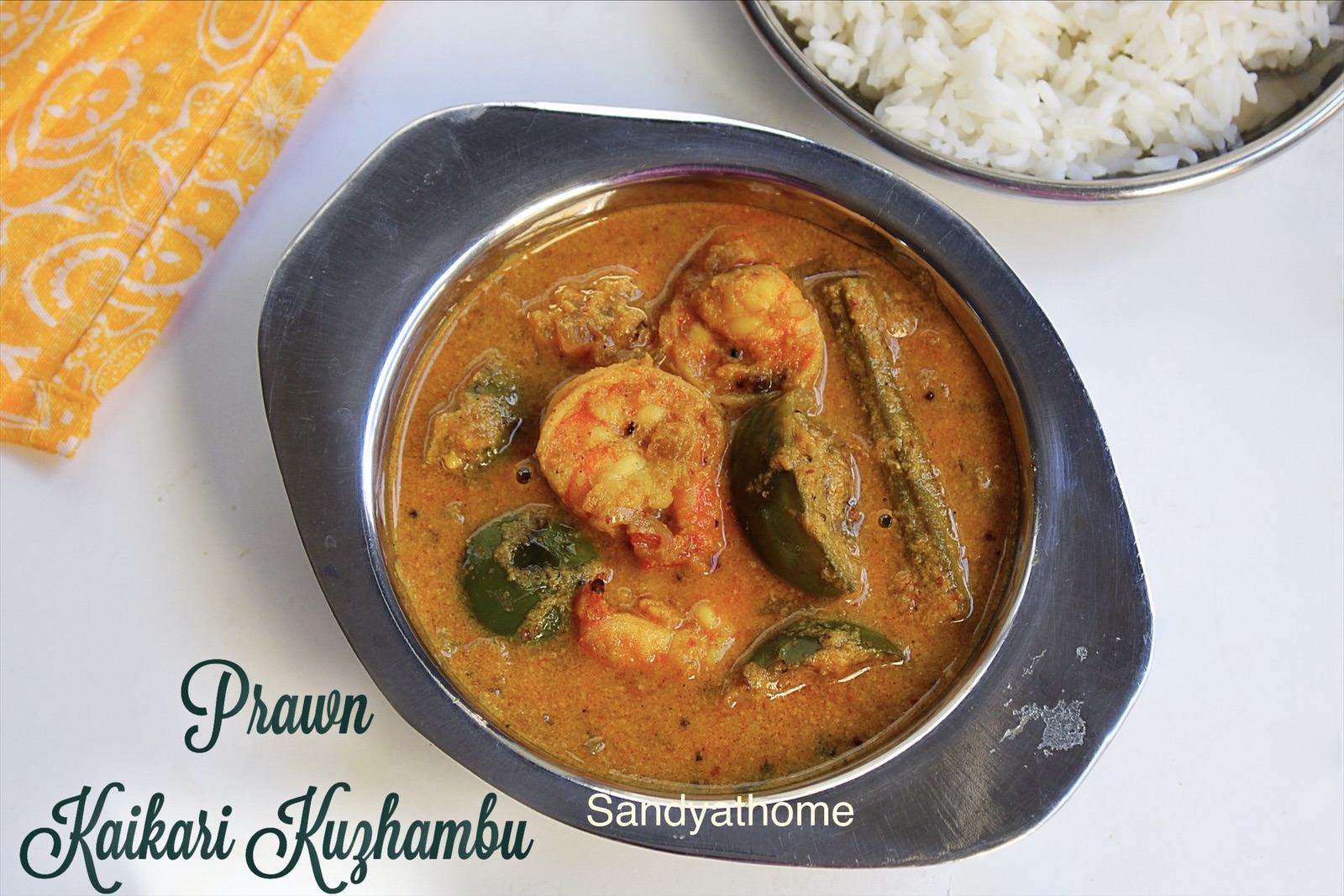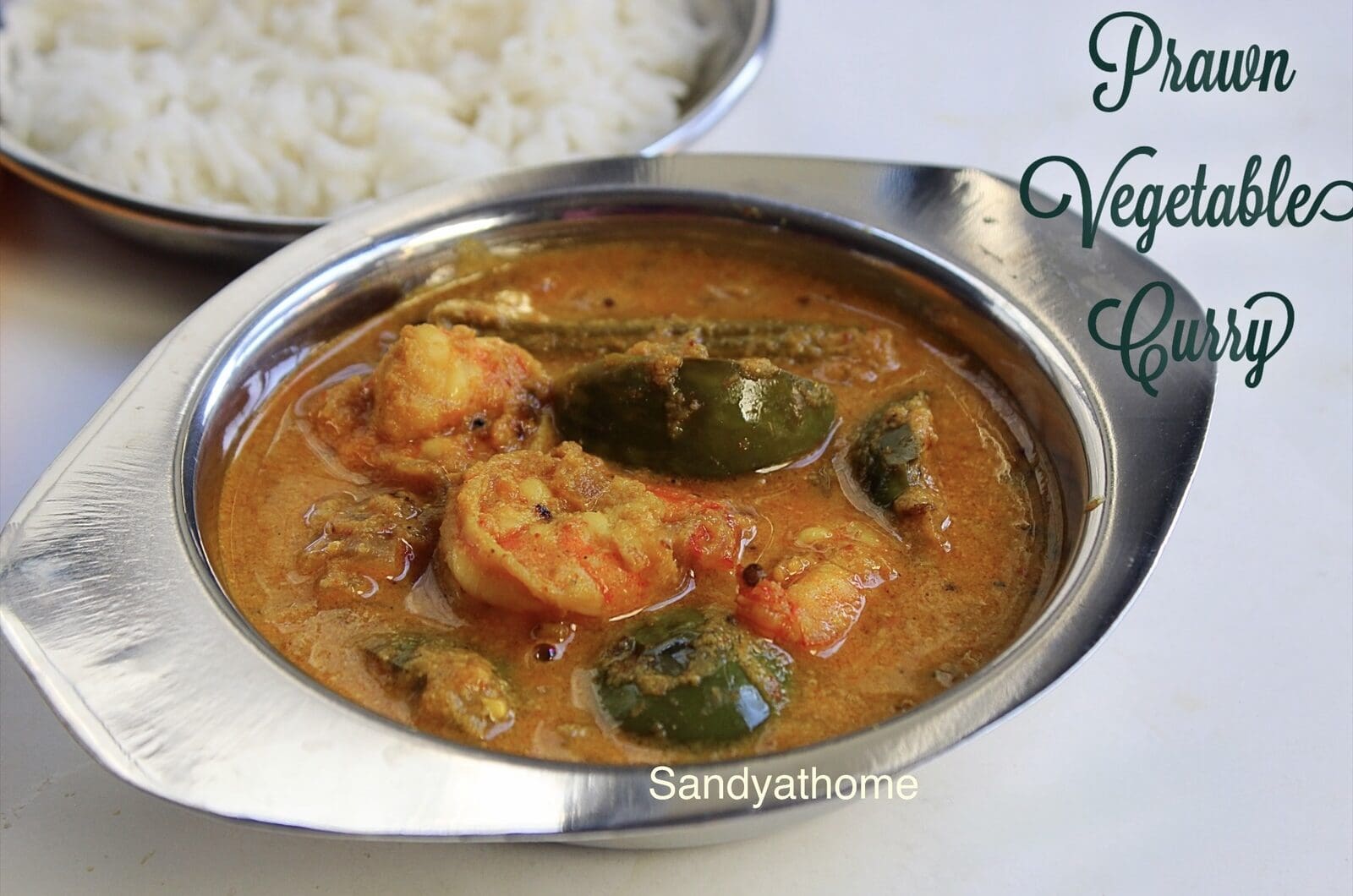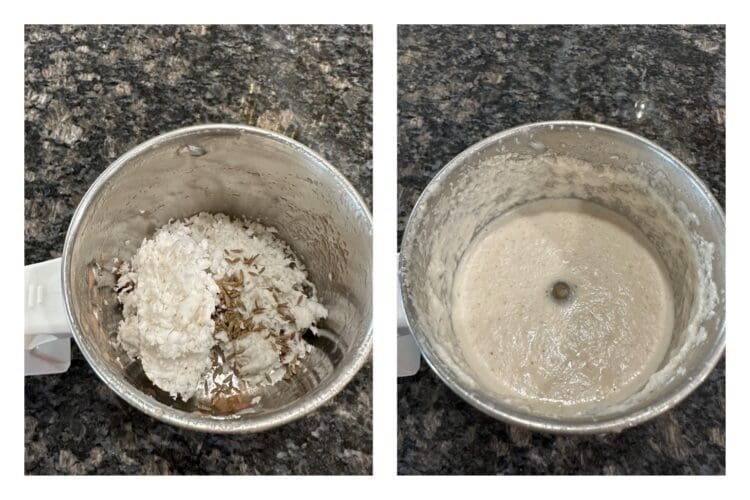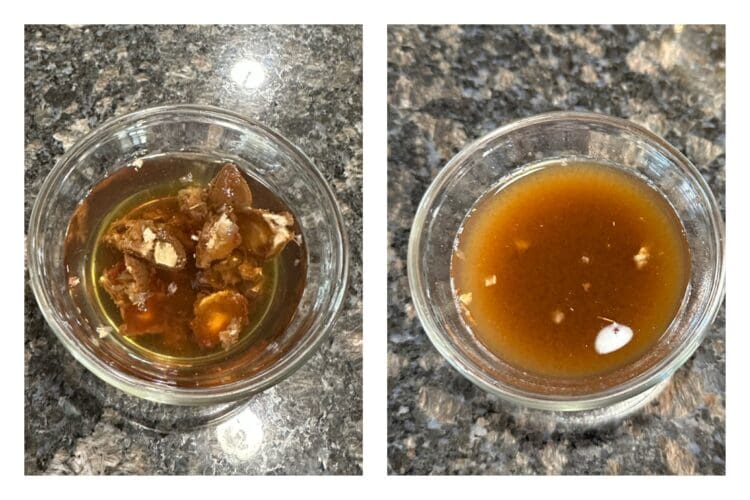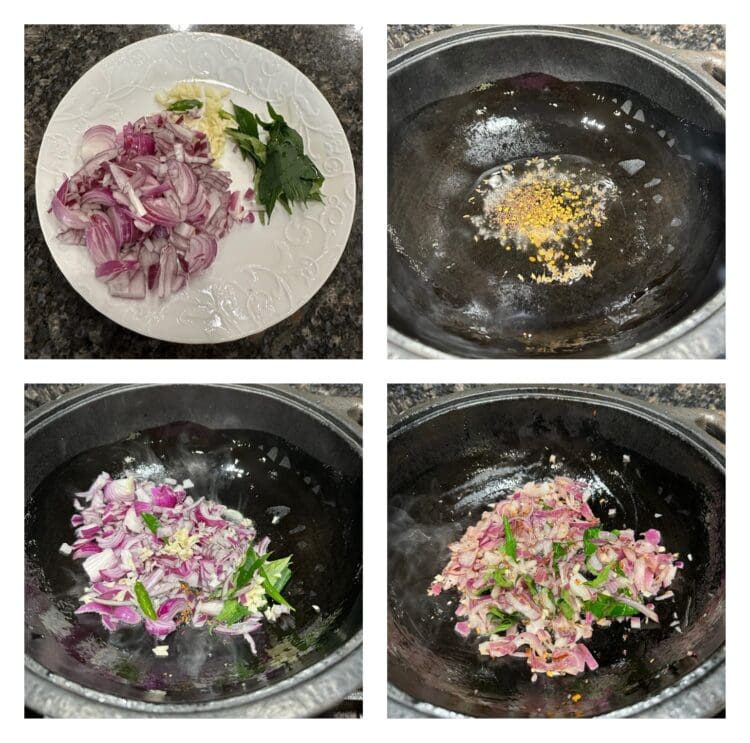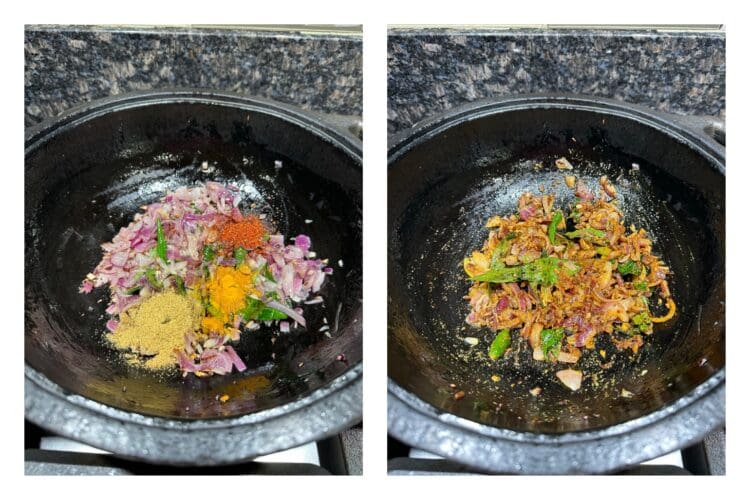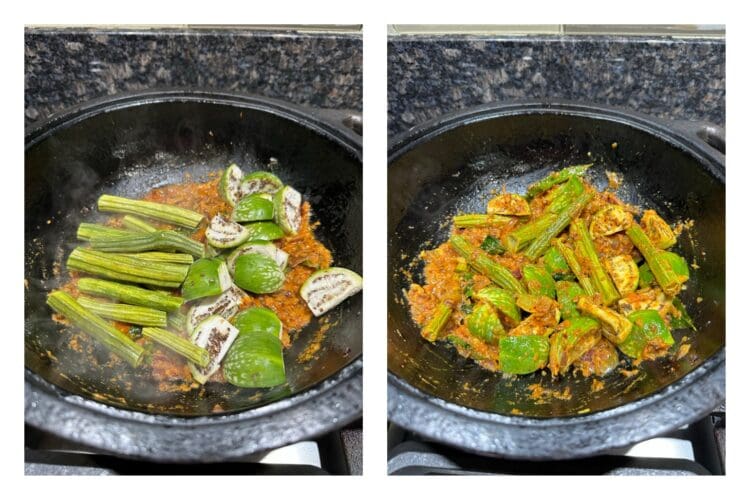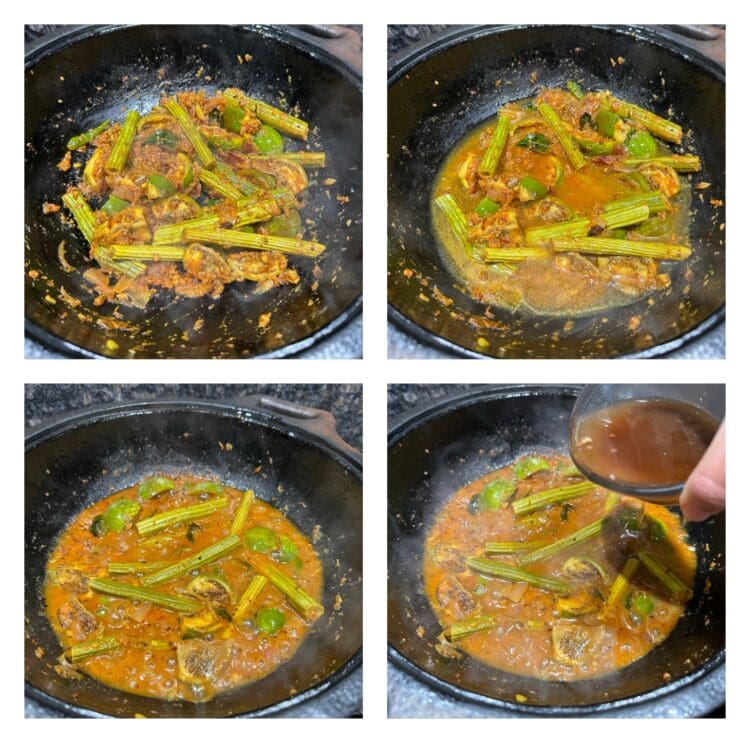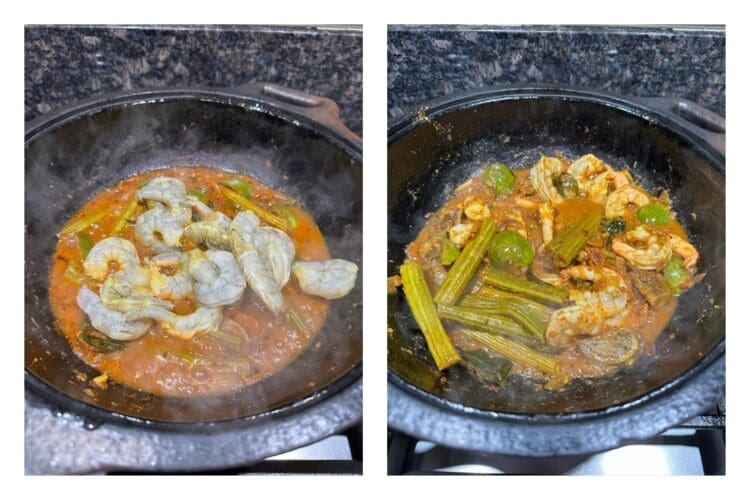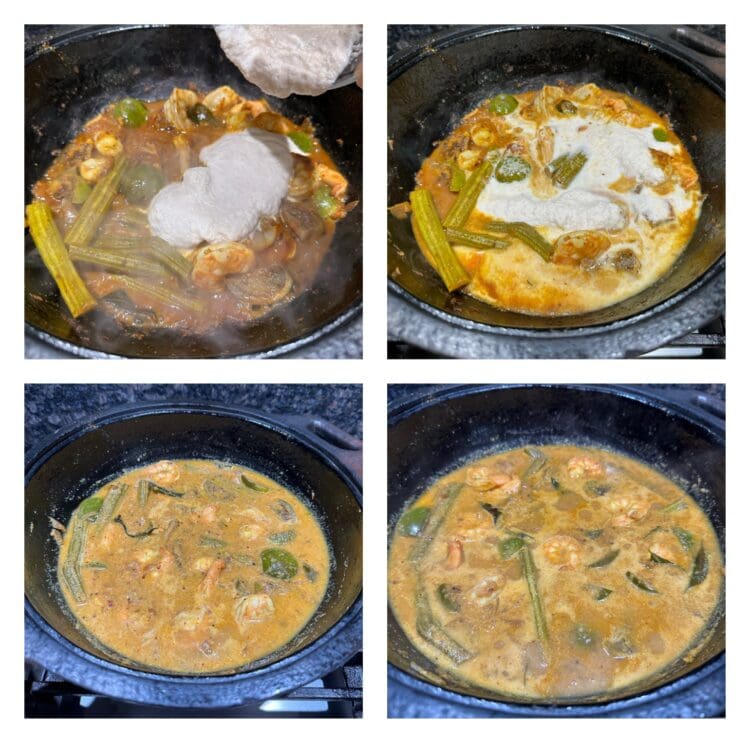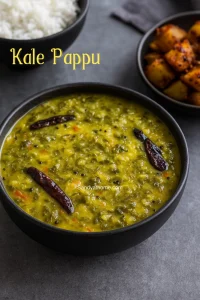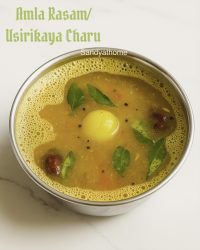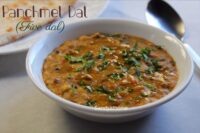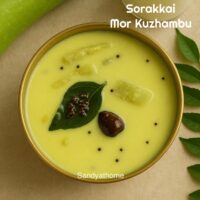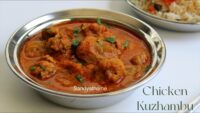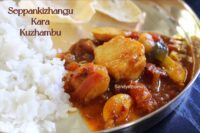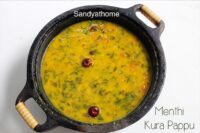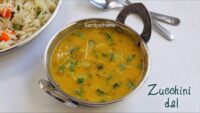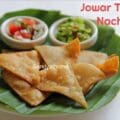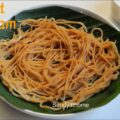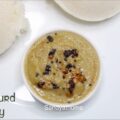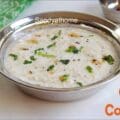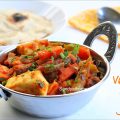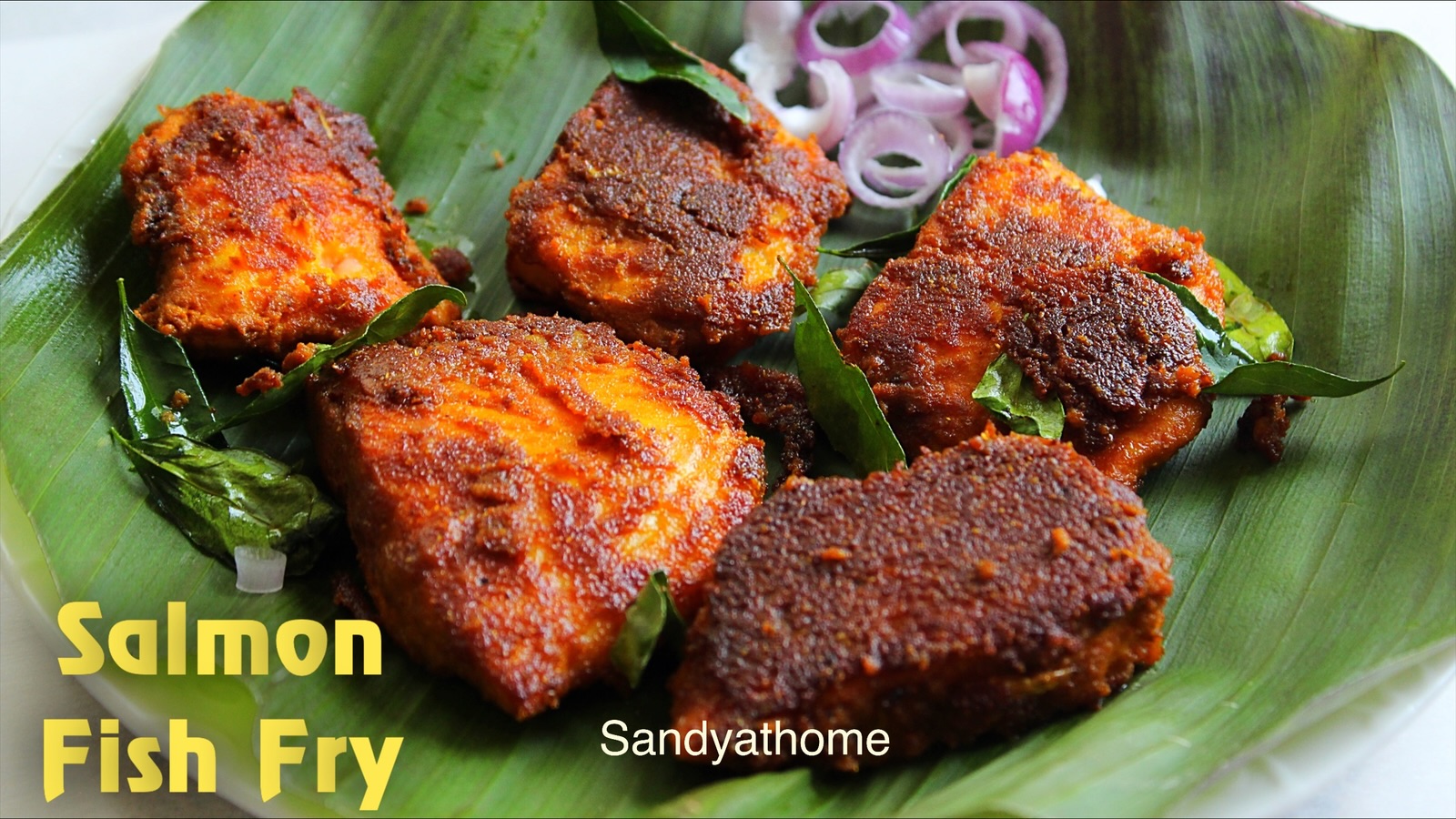Some kuzhambus don’t need elaborate spice blends. They just need time, memory, and a pot of soulful ingredients. This Prawn Kaikari Kuzhambu, also known as Eral Kaikari Kuzhambu in Tamil homes, is one of those quiet, forgotten weekday curries — made with fresh prawns, native vegetables like drumstick and brinjal, and a humble masala of grated coconut, jeera, red chilli powder, and coriander powder.
No grinding of spices, no garam masala — just a traditional Tamil-style prawn curry that once simmered slowly in coastal kitchens from Cuddalore to Karaikal.
This isn’t your usual prawn kuzhambu. It’s a revival recipe, rooted in fisherfolk flavors, where the sea met the backyard, and food was cooked with instinct, not measuring spoons. A village-style prawn curry that brings both sea breeze and nostalgia to the plate.
We’re bringing it back — one soulful ladle at a time.
Bite of History – Eral Kaikari Kuzhambu
Before spice powders lined our shelves and blenders became kitchen staples, Tamil coastal homes thrived on simplicity. In fishing hamlets along Nagapattinam, Cuddalore, and Karaikal, kuzhambus like this were everyday affairs — built on what the sea offered and what the backyard grew.
Prawns, caught in the morning and cleaned by noon, were simmered with seasonal vegetables like brinjal, murungakkai (drumstick), and spiced with just a few hand-pounded ingredients — jeera for warmth, coconut for body, and red chilli powder from sun-dried chilies ground at home. There were no “prawn masalas” — just instinct, memory, and the rhythm of the kitchen.
This Eral Kaikari Kuzhambu may not be documented in royal cookbooks, but it fed generations. It’s what a fisherman’s wife would cook on a breezy afternoon, with gingelly oil, homegrown curry leaves, and no written recipe — just feel.
Now, that feel is coming back to the table.
Jump to RecipeIngredients Role – Prawn Curry/ Kuzhambu
| Ingredient | Role in the Recipe |
|---|---|
| Prawns (Eral) | The star protein — brings a sweet, sea-salt flavor that deepens the kuzhambu’s taste. |
| Brinjal & Drumstick | Absorb the kuzhambu beautifully and add rustic, earthy texture. |
| Shallots | Adds mild sweetness and depth — key to any Tamil kuzhambu. |
| Tomato | Provides natural acidity and helps balance the richness of coconut. |
| Grated Coconut | Forms the creamy base of the curry, adding body and coastal warmth. |
| Jeera (Cumin) | Balances seafood flavor and aids digestion — often used in Tamil-style kuzhambu. |
| Tamarind | Adds tang and brightness to balance the sweet prawns and mellow coconut. |
| Red Chilli Powder | Brings color and controlled heat — no overpowering spice, just enough to warm. |
| Coriander Powder | Gives the kuzhambu its body and grounding spice — connects all other flavors. |
| Turmeric Powder | Adds earthy depth and natural antiseptic property — common in all Tamil curries. |
| Mustard & Methi Seeds | Used in tempering for a nutty aroma and subtle bitterness that balances the curry. |
| Curry Leaves | Infuses the oil and gravy with signature South Indian aroma — can’t skip this! |
| Gingelly Oil | The soul of Tamil kuzhambu — adds nutty depth and coastal authenticity. |
| Salt & Water | Salt enhances every flavor, while water brings it all together into a flowing kuzhambu. |
You May Also Like these Recipes:
Directions to make Eral Kaikari Kuzhambu with step by step images
- Grind the coconut masala
In a small mixer jar, grind ½ cup grated coconut with 1 tsp jeera and a little water to a smooth paste. Keep aside.
- Soak Tamarind
Soak a small gooseberry-sized piece of tamarind in ½ cup warm water for 10 minutes. Squeeze and strain the extract. Set aside.
- Temper and sauté the base
Heat 2 tbsp gingelly oil in a clay pot or thick-bottomed kadai.
Add ½ tsp mustard seeds and ¼ tsp fenugreek seeds. Let them splutter.
Add chopped shallots (8 to 10), green chilli, chopped garlic and a sprig of curry leaves. Sauté till soft.
- Add spice powders
Add 1½ tsp red chilli powder, 2 tsp coriander powder, ¼ tsp turmeric powder, Salt to taste
Sauté for a minute. till the oil begins to release from the masala.
- Add Tomatoes:
Add 1 ground tomato and cook till the oil begins to release from the masala.
- Add vegetables and simmer
Add brinjal (quartered) and drumstick (cut into 2-inch pieces).
Mix well with the masala. Add 1 cup water and cook covered for 5–6 minutes, until vegetables are halfway cooked.
- Simmer the Vegetables with Tamarind
Add 1 cup water to the sautéed vegetables and cook covered for 5–6 minutes until they’re halfway tender. Then add the tamarind extract, mix gently, and continue simmering uncovered on medium heat for another 5–6 minutes until the raw smell fades and the kuzhambu slightly thickens.
- Add prawns
Now add the cleaned prawns (250g / ~1¾ cups). Mix well.
- Add coconut paste
Pour in the ground coconut-jeera paste. Simmer on low heat for 5 – 6 minutes until the prawns turn opaque and are just cooked. Switch off when oil floats and the kuzhambu thickens slightly.
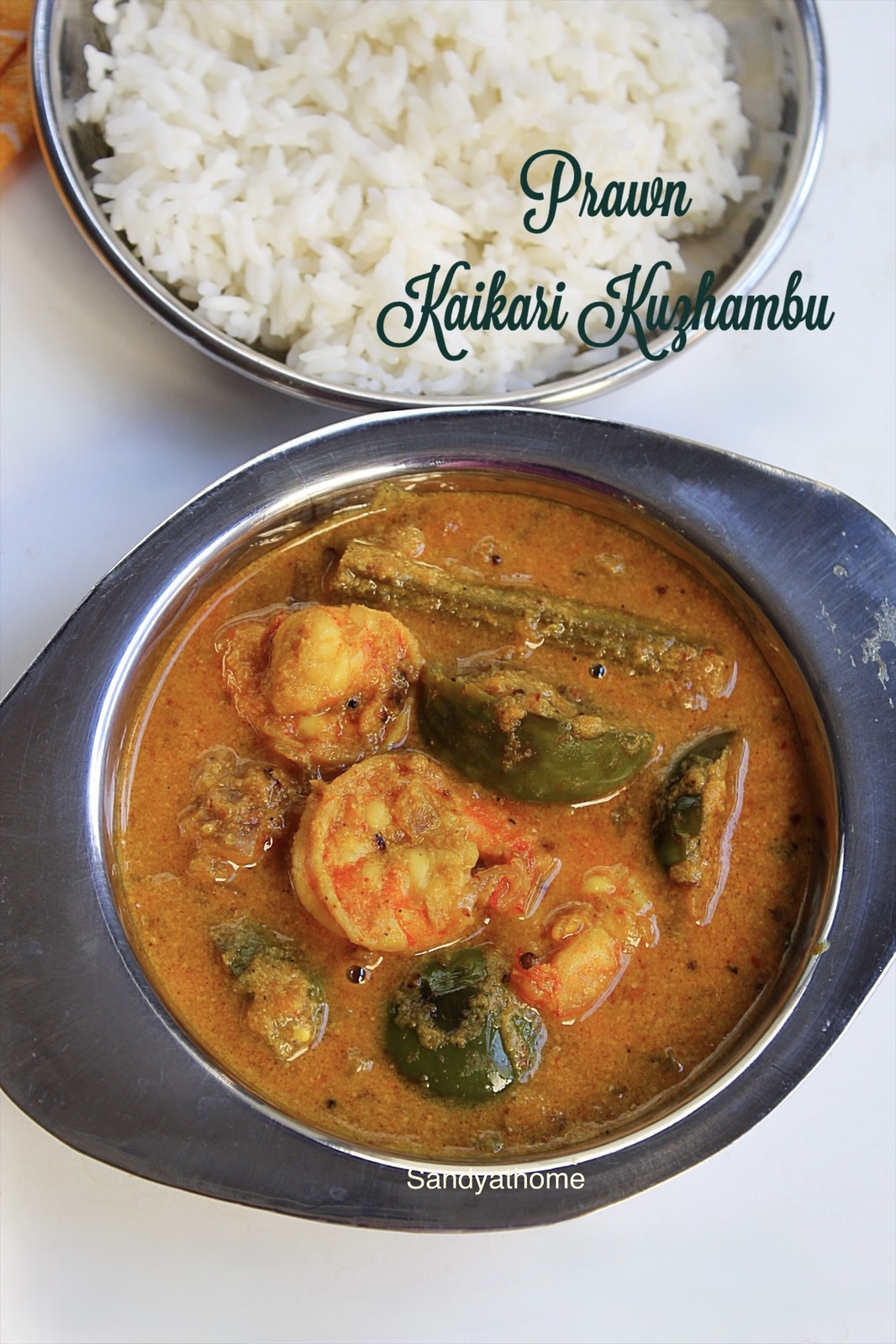
Pro Tips for Prawn Curry with Brinjal and Drumstick
- Don’t overcook prawns – They cook quickly (in 6–8 mins) and turn rubbery if left too long. Always add them last.
- Use gingelly oil for authenticity – It brings that deep, nutty aroma so typical of Tamil coastal kuzhambus. Don’t skip it.
- Let the masala simmer – After adding coconut paste and tamarind, give the kuzhambu 5–7 mins to reduce and deepen in flavor before adding prawns.
- Balance with jaggery (optional) – If your tamarind is too tangy or tomatoes too acidic, a pinch of jaggery rounds off the flavors beautifully.
- Chop shallots finely – So they melt into the kuzhambu and form the base. They should not stand out like chunks.
- Brinjal and drumstick must be halfway cooked before adding prawns – Since prawns need very little time, the vegetables should already be tender.
- Use medium-sized prawns – They absorb flavor better and hold their shape nicely in the kuzhambu.
- For thicker kuzhambu – Simmer uncovered for the last few minutes to let it naturally reduce and coat the back of a spoon.
Serving suggestion Eral Kuzhambu
Serve this prawn kaikari kuzhambu hot with:
- Steamed rice and a spoon of ghee
- Ragi kali or kambu rice for a rustic millet meal
- Idiyappam or dosai for special occasions
Pair it with keerai poriyal, raw banana fry, or appalam for a complete coastal-style lunch.
FAQ – Prawn Curry
Yes! In many traditional Tamil homes, prawn kuzhambu is made with vegetables like brinjal (kathirikkai) and drumstick (murungakkai). They soak up the kuzhambu beautifully and add a rustic, home-cooked feel.
Brinjal, drumstick, ash gourd, and raw banana are commonly used in kaikari kuzhambu variations. They pair well with prawns and coconut-based gravies, and are loved in coastal Tamil Nadu cooking.
This recipe is perfect for you! Just use grated coconut, jeera, red chilli powder, and coriander powder — no complex grinding required. It keeps the curry simple yet flavorful.
Absolutely. Many Tamil-style prawn kuzhambu recipes — especially in the coastal belt — use fresh grated coconut as a base, either raw or roasted, for depth and body.
The traditional version is known as Eral Kuzhambu or Eral Kaikari Kuzhambu, made with gingelly oil, coconut, tamarind, simple spices, and optionally, vegetables like brinjal and drumstick. It’s a revival recipe rooted in fisherfolk kitchens.
It’s a coastal Tamil curry made with prawns (eral) and vegetables (kaikari) in a coconut-spice base. This version uses minimal ingredients — just coconut, jeera, and pantry masalas — and is one of the simplest yet most soulful prawn curries you can make.
Yes, but it will be milder. You can skip onion and tomato and rely solely on coconut, jeera, chilli powder, coriander, and tamarind for flavor. Many paati-style kuzhambus follow this no-onion method.
Not too much. You control the heat with just red chilli powder — no green chillies or pepper involved. It’s flavorful, not fiery, and perfect for family meals.
Yes! Though traditionally eaten with hot rice and ghee, it also tastes divine with ragi kali, thinai arisi, idiyappam, or even dosai — especially if you’re doing a revival millet twist.
Kuzhambu Recipes
Andhra style Kale Pappu, How to make Kale Paruppu
A wholesome South Indian–style dal made with toor dal, garlic, and fresh kale leaves. Whether you call it Kale Paruppu, Kale Pappu, or Kale Dal, this one-pot curry brings together traditional flavors and modern greens for a nourishing lunch
Amla Rasam, Usirikaya Charu, How to make Nellikai Rasam recipe
This traditional Amla Rasam, also known as Usirikaya Chaaru, is made with halved gooseberries, garlic, and freshly crushed spices. It starts with tempering to enhance flavor and is perfect for summer or anytime your body needs a gentle, immunity-boosting dish.
Paruppu Urundai Mor Kuzhambu, How to make Mor Kuzhambu
Paruppu Urundai Mor Kuzhambu is a traditional Tamil kuzhambu made with steamed lentil balls simmered in a cooling curd and coconut gravy — perfect for summer lunches and no onion, no garlic cooking days.
Panchmel Dal recipe, How to make Panchratna Dal
Panchmel Dal, also known as Panchratna Dal, is a traditional Rajasthani dish made using five dals, cooked with a fragrant tempering of ghee, cumin, and chilies. Serve with rice or roti for a soulful, protein-packed Indian meal.
How to make Chukka Kura Pappu, Andhra Sorrel leaves Pappu
A traditional Andhra-style dal made with sour chukka kura (Indian sorrel) and toor dal — this no-onion, no-tomato recipe is rooted in village kitchens and summer wisdom.
Bottle Gourd Mor Kuzhambu, How to make Sorakkai Mor Kuzhambu
Bottle gourd mor kuzhambu is a summer-favorite Tamil-style buttermilk curry made with sorakkai, coconut paste, and simple spices. This dump-style kuzhambu is soothing, gut-friendly, and part of ancient revival recipes from South India.
Muslim-Style Chicken Kuzhambu, How to make Chicken Kuzhambu
This rich Muslim-style chicken kuzhambu is made with ground coconut, whole spices, and pepper — a traditional family favorite perfect for Bakrid and beyond.
Seppankizhangu kara kuzhambu, Arbi kara kuzhambu
Seppankizhangu kara kuzhambu/ Arbi kara kuzhambu is a delicious tamarind based gravy/ kuzhambu prepared with Seppankizhangu/…
Menthi kura pappu, Methi dal
Menthi kura pappu (Methi dal) is a a delicious and nutritious lentil based dish prepared…
Zucchini dal recipe, Zucchini pappu
Zucchini dal/ Zucchini pappu is a delicious and very easy to make lentil based side…
